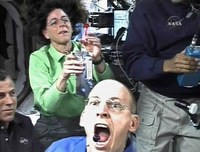Category: Science
International Space Station astronauts indulging in urine-drinking party tonight
You wouldn’t think people would ever be pleased to hear they can start drinking their own urine – but the astronauts on the International Space Station are currently over the moon about it.
“There will be dancing later,” Mission Control said, after ISS commander Mike Fincke told Earth that the the orbiting station’s faulty urine processor – which filter space wee, condensation and SWEAT and turns it into lovely drinking water – was finally fixed.
This raises two important questions – how do you dance in zero gravity? And before…
Last.fm mashup maps every artist ever
This beautiful cloud represents the entirety of music. Every single artist tracked by Last.fm is marked as a point on the map, and ‘similar’ artists are connected by a grey line. The size of each point reflects the popularity of the artist, and different colours represent different genres.
It’s the creation of Budapest University PhD candidate Nepusz Tamas, who hammered Last.FM’s servers for over a week with a request every five seconds. Unfortunately, the only way to interact with the map is to pinpoint your favourite bands, and you can’t zoom in, but it’s still a beautiful representation of the world’s listening habits.
Reconstructing the structure of the world-wide music scene with Last.fm (via Listening Post)
Related posts: Last.fm gets a makeover – and a few new features | Viacom wins right to sift through YouTube user data, all four terabytes of it
Chinese researchers develop carbon nanotube speakers
What’s “tens” of nanometres thin, contains no moving parts, and blasts out Mariah Carey’s “All I Want For Christmas Is You” all day long? Carbon nanotube speakers developed by researchers at China’s Tsinghua University, that’s what.
One-eyed artist plans Borg-like installation of webcam into her spare eye socket
San Francisco-based artist Tanya Vlach lost an eye in a car accident in 2006 – now she’s planning to replace her standard-issue fake eye with a webcam. Preferably wireless – and with a 3x zoom. And infra-red support so she can see what she does in the dark.
Here’s what Tanya asked for in an advert she placed for a suitable technician for the job…
Hadron Collider repairs to cost £14m
Turns out that fixing the slight liquid helium leak down below Geneva earlier this year is going to cost rather more than the vase you knocked over at Auntie Flo’s house when you were 13, which cost you all your pocket money for the following three months. To be precise, the exact cost of fixing the LHC is £14 million.
The team behind it also say that “realistically”, it’s going to take until next summer before things are up and running again. Originally, we thought that it’d be going again around now, but the damage was more severe than the team realised. Most concerningly of all, the cost of fixing the thing ‘falls within CERN’s budget’. Damn – that’s one hell of a budget.
Related posts: OPINION: The Large Hadron Collider goes live tomorrow – fingers crossed | Teen suicide over LHC Apocalypse fears; let’s rename the beast
VIDEO: Energy & Efficiency, episode 8
Today’s energy saving tip is to do with the vacuum cleaner. The common ‘Hoover’ is a massive drain of electricity, regularly sucking up POUNDS AND POUNDS worth of your electricity and therefore also the very fabric of planet Earth. But! You can stop this from happening! You can vacuum AND SAVE!
Watch my exclusive video on making your own, free, energy efficient vacuum cleaner out of household equipment to learn how…
You are not allowed to steal this idea. It is MY IDEA. I’ve emailed a rough outline of the concept to Sir James Dyson, the vacuum cleaner tycoon…
BATTERY DEVELOPMENTS: Korean scientist claims eight-fold leap in power-up time
It is a bit of a shame and quite an embarrassment for mankind that batteries haven’t come on in leaps or bounds since the 1970s, with modern Duracells only being marginally better than the Duracells used to power a Big-Trak for about 35 minutes on Christmas Day, 1981.
But that might possibly be about to change – thanks to a man called Prof. Cho Jae-phil who works at the Department of Applied Chemistry at Hanyang University, in South Korea…
Commission urges action over nanotechnology pollution
Here’s something new for the tabloids to get angry about without understanding. The Royal Commission on Environmental Pollution has recommended “urgent regulatory action” over the microscopic materials present in sun creams, sports clothing and medicine.
The commission warns that although hundreds of consumer products are already in the marketplace that use nanoparticles, we have an ‘almost complete lack of knowledge’ regarding their long-term effects on human health and the environment. The report says many nanoparticles are so poorly understood that scientists don’t even know how to check their safety.
iPod headphones a possible KISS OF DEATH for users with pacemakers
Dr William Maisel, a cardiologist at the Boston-based Beth Israel Deaconess Medical Center, caused heart-murmurs across the internet this weekend thanks to his claim that music player headphones could break pacemakers – and stop defibrillators restarting dodgy hearts.
It’s all because of the magnets in headphones, which could, possibly, if held very close to them, make pacemakers and other “embedded” medical devices stop working. After testing eight models of headphones on 60 patients with pacemakers, the doctor found that nearly a quarter of patients’ heart devices suffered some sort of interference…
FAKE SCIENCE: Alternate universe-generation kit, yours for $20
We really haven’t been paying enough attention to the part of science that deals with multiple universes.
Because, from next month, you will be able to buy one of these – a make-your-own-universe kit. It’s based around some fancy science that states there’s an infinite number of possible alternate universes, and more are created each time any kind of measurement is taken that defines one particular place. Or something along those lines…
















